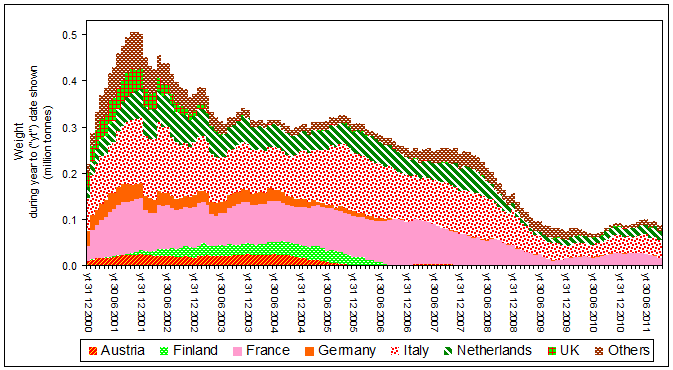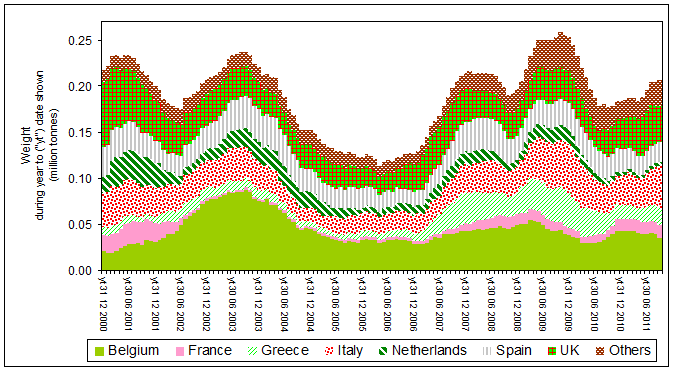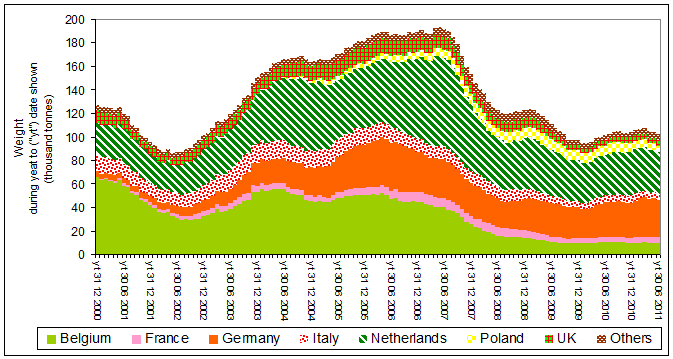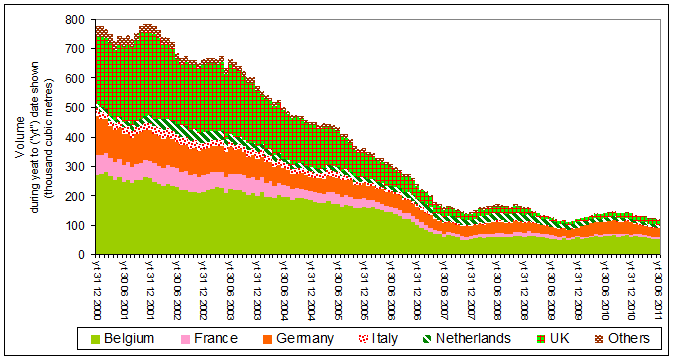|
|
||
|
Click here for initial briefing Paper Sector Timber
Sector 1) - General considerations: The two largest groups' pulp and palm oil businesses - particularly the largest, market their businesses as environmentally and socially sound. They do so partly to counter the general perception that they contribute much not only to Indonesia being the world's third largest emitter of anthropogenic greenhouse gas emissions, but also to loss of biodiversity and the impoverishment of long-established forest peoples' livelihoods. Even if some of their pulp or paper is not illegal, Operators placing products on the market which include at least some fibre from these groups risk being ostracised by the market (not only consumers) for tending to maximise the climate change footprint of the products which they supply and for contributing to the extinction of iconic species (notably the orangutan and Sumatran tiger[*]). Perhaps the only other mill worldwide which continues to use tropical timber as pulpwood is in Sabah. That mill used to be associated with the largest of those pulp milling groups. However, given the quantities supplied, it is much more likely that Indonesia, not Sabah, is the origin of fibre from tropical forest if tests show that such fibre is included in consignments of pulp or paper. Much of the paper supplied from China - be this as printed matter (HS code 49), paper (HS code 48), or as the packaging of other products being exported - is likely not only to include at least some fibre from Indonesia (given that most of Indonesia's exports of pulp and paper are supplied to China) but also to be supplied by enterprises associated with Indonesia's two largest pulp milling groups - particularly the largest. It seems that Indonesia is perceived as a high risk source of pulp and paper in the context of the USA's Lacey Act[*]. It is therefore remarkable that the weight of pulp and paper imported into the USA from Indonesia has tended to increase since the Lacey Act became applicable to those product groups. The trend prior to that had been downwards. (The same applies to other products and other high risk supplying countries.)
Acacia mangium - also grown for pulpwood in Sabah[*] and Vietnam. Acacia crassicarpa - grown on peat[p86][slide 11], predominantly in Indonesia and therefore not only indicative of being milled by at least one of three controversial Indonesian groups but implicitly also having an exceptionally large greenhouse gas footprint. Mixed Tropical Hardwood ("MTH") - also referred to (disingenuously) as Mixed Wood Residues ("MWR")[Tables 10 & 18][p15] or Mixed Hardwood ("MHW")[p70]. In so far as Indonesia is the only country in the world which uses tropical forest as a source of pulpwood, pulp or paper products containing fibre from tropical forest species will have been milled by at least one of three controversial Indonesian groups - the two largest of which have repeatedly broken public commitments to cease using tropical timber as pulpwood.[p3][slide 11] However, some such species have been (and might still be[*]) used as pulpwood in Sabah (by a relatively small mill which exports only some of its output[p10]).[4.2.1] 3) -
Products:
France, Italy and the Netherlands have led the EU's imports of pulp from Indonesia since early last decade. Almost all of this comprises chemical pulp (HS code 4703). The quantity imported into the EU has changed little since EC Regulation 995/2010 was adopted. Its import value during 2010 was approximately Euro50 million. There are four pulp milling groups in Indonesia. The mills appear to have been established fraudulently - particularly in their financing and, with one exception, their supplies of pulpwood. Although that mill is owned by Japanese interests, it supplies pulp worldwide. The smaller of the other three pulp milling groups is said[¶1 page8] to have links with Indonesia's military (which has been ordered to withdraw from commerce) and appears to be operating at well below full capacity. The founder of the second largest fled the country to Singapore (in effect, a safe haven) when about to be tried for irregularities concerning banking aspects of his conglomerate. The FSC-certificate for pulpwood milled in Indonesia by the group has been withdrawn due to fundamental breaches in performance.[*] The largest (including its affiliates world-wide) has been black-listed by the FSC[*] and accused of being at least complicit in illegal logging in Yunnan[*] and Hainan[*] (the group being one of the largest in China's pulp and paper sector). The two largest groups appear complicit in the supply of illegal pulpwood[*][*][*][*] (including through the use of fire to clear forest[Slide 19][final two¶ p4]). Indonesia imports a substantial weight of pulp from low risk countries (in the order of one million tonnes each year). The weight imported is small relative to the weight of pulp which is milled in Indonesia.
Much of Indonesia's paper industry uses pulp based on waste paper as its primary source of fibre, particularly for the packaging in which other products are exported. At least some if not most of that pulp is likely to be strengthened by mixing with some virgin fibre (from imports or pulp mills in Indonesia). The substantial weight of newsprint (HS code 4801) which Indonesia exports (particularly to South Korea) is likely to derive primarily from waste paper, and is likely to account for most of Indonesia's exports of commodities which are based on waste paper. Given the quantities involved, a much greater proportion of Indonesia's other exports of paper is likely to have been made from pulp deriving from pulpwood grown in Indonesia rather than imported pulp. As the chart above illustrates, the Netherlands (a distribution hub) is the only EU Member State which reduced its direct imports of paper from Indonesia last decade. It is unclear to what extent the Netherlands' trend reflects concern about the reputational risk of associating with the groups which are likely to supply most of the EU's imports of paper from Indonesia, or perceptions of the illegality of those imports. Contrary to what one might expect given such concerns, the weight of paper imported into the EU from Indonesia has increased since EC Regulation 995/2010 (which enters force on 03 03 2013) was announced. The import value of that paper amounted to roughly Euro 180 million during 2010. It is unclear whether Indonesia's SVLK (a nation-wide legality assurance system for wood-based products) covers pulp (and implicitly also paper) which either derives at least partly from tropical forest irrespective of the type and designation of that forest or is made in fraudulently established mills. It appears that the SVLK is being introduced gradually. It would be surprising if the SVLK were already mandatory for either pulp or paper. The SVLK is likely to form the basis for FLEGT-licensed wood-based products under the proposed Voluntary Partnership Agreement between Indonesia and the EU. There is sufficient concern about deception in relation to information provided by the leading suppliers of pulp and paper to warrant the view that SVLK certificates should not be sufficient evidence concerning the legality (or sustainability) of their products.[*][*][*]
In so far as Indonesia's 50-year occupation of Papua continues to be illegal, timber originating from Papua, whether or not exported directly from there, is likely to be illegal - unless supplied with the free prior informed consent of indigenous Papuan communities (as distinct from individuals or enterprises purporting to represent them). As a proportion of the roundwood equivalent volume of timber sector products which Indonesia exports, plywood accounts for roughly double the total for all other such products. Wood-based panels (other than plywood) made from residues which derive from the milling of tropical logs are implicitly as illegal as those tropical logs. Although the volumes involved reduced sharply during the middle of last decade[p28], a substantial quantity of timber is probably still smuggled out of Indonesia - primarily to Malaysia[p16] (including via Free Trade Zones in Singapore[p6]) and probably to a lesser extent China. Operators should expect that timber sector products made in some countries, particularly China, out of wood exported from Indonesia are more likely to be illegal than similar products exported direct from Indonesia. Estimates of the quantity of illegal timber supplied from Indonesia tend to be based on inappropriate analyses (assessing data mismatches) and/or superficial, ignoring differences between products, suppliers, destinations, sub-national regions.[*] [p94] By the time EU Regulation 995/2010 enters into force, Indonesia's Timber Legality Verification System ("SVLK") will have had more than two years in which to become established - and might apply to all wood-based products[¶"1" p8] made at least partly from trees felled in Indonesia, regardless of origin. Although this would greatly facilitate due diligence by Operators, the difficulty[*] of obtaining sufficient evidence of such fundamental assets as credible plans for the (sustainable) management of permanent forest, full gazettement, and whether the logs were felled by properly authorised enterprises in an unambiguously and properly attributed concession which has been properly desginated for such logging might still be insuperable. Operators should also consider who the controlling interests (not only the main shareholders) of the concessionaire are - in order to avoid the risk of being linked to the military, the family and associates of former President Suharto, groups known to have reneged on their debts, and/or groups or individuals which have evaded conviction or substantial penalty for forest-related crime despite being tried in court with convincing evidence. Operators should also consider whether to become complicit in causing Indonesia's greenhouse gas emissions and the extinction of species, through procurement from those whose businesses include operations on peat- and/or of high conservation value (including buffer zones and linked zones which help avoid fragmentation).{Footnote 1} In addition to being morally reprehensibile, these latter considerations reflect the past failure of Indonesia to manage its forest sustainably and equitably[p13-14] in compliance with the intent of its constitution and law. Helping rectify this, the SVLK currently requires that social and environmental considerations are taken into account[final ¶ p5 et seq][*] and is widely supported. Indonesia restricts the export of products made from a number of species, including ramin Gonystylus spp. which is listed in CITES and ulin Eusideroxylon zwageri[*]. Indonesia has not seriously supported proposals for a CITES-listing of merbau Intsia spp.[p26] (the focus of illegal exploitation[p5] in occupied-Papua, whose forest has been rich in this species). The IUCN Red List[*] suggests that the conservation status of most species of trees from which Indonesia's exports of tropical timber derive is either vulnerable or more serverely threatened with extinction - notably several species of Shorea, including most forms of dark red meranti (other than Shorea curtisii) (which account for most of the Indonesia's tropical timber production[*]) and some forms of bangkirai / yellow balau[*] (other than Shorea laevis). Their conservation status is similar to that of those species of Dipterocarpus (which includes keruing), Palaquium (which includes nyatoh), Dryobalanops (which includes kapur) and Anisoptera (which includes mersawa) which grow in Indonesia. Other species, such as Koompassia (which includes kempas) and Dyera (which includes jelutong) appear to be less vulnerable. The status of tropical timber species is likely to have deteriorated since their entries in IUCN Red List were last revised (during the 1990s). Tree species used in timber products and grown on plantations in Indonesia include teak Tectona grandis, mahogany Swietenia macrophylla (listed in CITES), pine Pinus merkusii, and albizia/falcata Paraserianthes falcataria.
China's rapidly increasing imports of sawn wood from Indonesia (c.300,000m3 during 2011 via Jiaxing) presumably do not breach Indonesia's prohibition on sawn wood exports if that wood derives from plantations (probably albizia/ falcata for use in blockboard).
In order to evade the export ban, it is likely that sawn timber is classified as mouldings (HS code 4409) - compounding the products' illegality.{Footnote 2} This seems apparent particularly in relation to Taiwan's imports of mouldings from Indonesia. However, it also seems that importers in some countries (notably China) declare Indonesia's (and Peru's) exports of mouldings as sawn wood - perhaps to evade import taxes. Under World Customs Organisation rules the first four digits of commodity codes assigned to exports should be the same as those of the corresponding imports.
Most of Indonesia's plywood exports are likely to be illegal - deriving from illegally acquired concessions or other forest areas which are not being logged - perhaps by enterprises ineligible to be logging - in breach of the Forestry Law of 1999 (which requires that forests are managed equitably and sustainably - accomodating the aspirations of forest-dependent communities[p13]). The provision of external technical assistance to those managing specific concessions[*] enhances perceptions of the legality and sustainability of their output - but does not eliminate the need for further due diligence. Some of these concessions appear to have links to one or more of the military[¶4 p8], the family of former President Suharto[*], a notorious logging multi-national[directors] and heavily indebted groups acquired by the Indonesian Bank Restructuring Agency[p2]. A small proportion of the plywood which Japan imports from Indonesia is likely to be have been made either partly of wholly from wood from plantations.[KTI]
A minority of the wooden furniture which is imported from Indonesia into the EU is likely to derive at least partly from trees of species from forest. For outdoor furniture patrticularly, those species include nyatoh, balau, keruing and, to a lesser extent merbau. The management of Indonesia's extensive teak plantations has been controversial (including violent).[*] Consquently, Operators should assess the credentials[*] of the estate(s) from which each consignment derives (which need not present problems for small-scale manufacturers[*] in Jepara). Footnote 1: Three metres is a somewhat artbitrary depth for forest conversion and tends to be measured where the peat is shallowest. The Mega Rice[slides 9, 16-24] scheme illustrates the carbon emissions and the unsuitability of peat soils for agriculture (including plantations). Footnote 2: This seems apparent particularly in relation to Taiwan's imports of mouldings from Indonesia. However, it also seems that importers in some countries (notably China) declare Indonesia's (and Peru's) exports of mouldings as sawn wood - perhaps to evade import taxes. Under World Customs Organisation rules the first four digits of commodity codes assigned to exports should be the same as those of the corresponding imports. |
||
|
|
||







